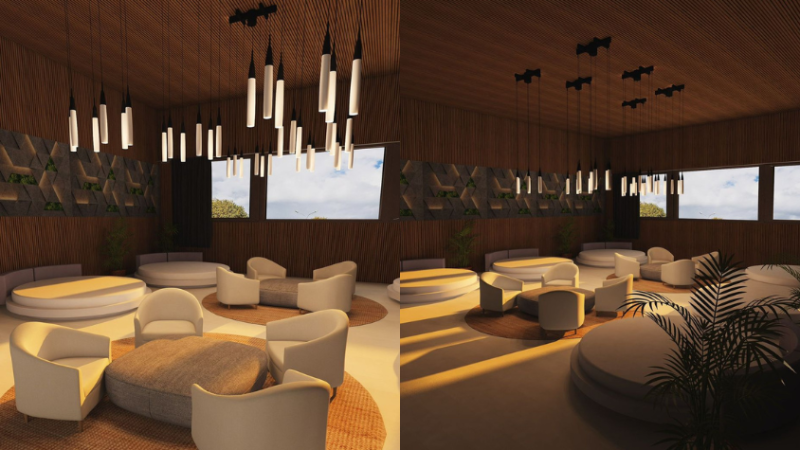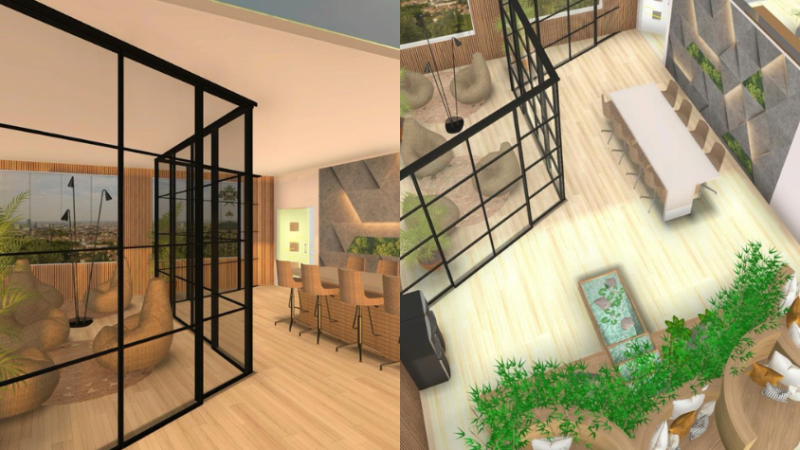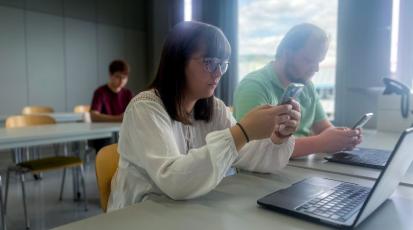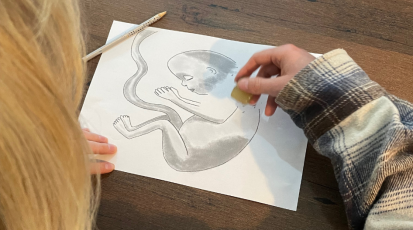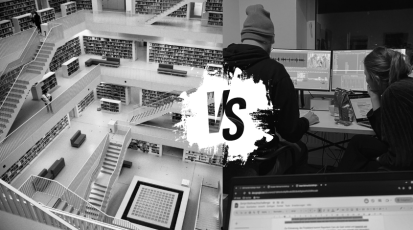"We are living in an age of digital overload.“
Learning Environments in Universities
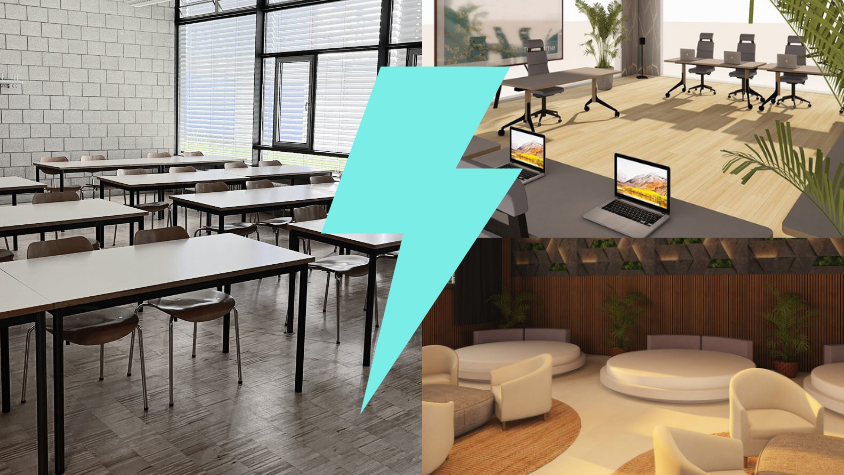
The Future of Universities: A Perspective through Professor Sandhu's Eyes
In a world that is constantly changing, universities are also faced with the challenge of adapting their teaching methods and learning environments. Professor Sandhu takes a look at the future of higher education. He has more than a decade of teaching experience at the HdM, and his courses include the module "Organizational Communication". However, his teaching style in this module goes beyond the mere imparting of theoretical knowledge.
Sandhu takes an unconventional approach by deliberately avoiding digital media and organizing the course in a different environment: a circle of chairs. "We live in an age of digital overload," explains Sandhu. That is why he wants to give students the opportunity to focus entirely on direct interaction and interpersonal communication. "Today's generation is often so dependent on smartphones and laptops," he adds. The choice of the chair circle as a teaching format was not only a departure from traditional teaching methods, but also a conscious challenge for the students. In a typical class room with fixed rows of chairs and tables, many students initially feel uncomfortable when they are suddenly asked to actively take part in the lecture. But that is precisely where the educational value lies, according to Sandhu: "By changing the physical environment, we encourage students to rethink their way of thinking and to actively shape their own role in the learning environment."
Students' feedback has been mixed, Sandhu says. About two-thirds have responded positively to the challenge and appreciate the opportunity to learn in an interactive and personal environment. However, the remaining third prefers to return to the "normal" classroom with digital media, as they find the alternative structure unfamiliar and feel more comfortable sitting in rows.
Sandhu is calling for more comprehensive reforms in educational practice. His vision includes flexible teaching methods and intensive, one-month modules that focus on a few topics—an approach that he believes would improve learning intensity and retention. Despite resistance to institutional norms, Sandhu remains optimistic about the future of education at the HdM. He wants students to take an active role in their learning process. "It's about feeling empowered to change things and realizing that we are not just passive actors in our environment," he emphasizes.
Finally, Sandhu also encourages his colleagues and educational institutions to be bold and experiment with new teaching methods. "If we are not willing to experiment, we cannot expect change," he explains. "The world is changing rapidly, and we must be prepared to change along with it."
The Impact of Lecturer Expertise and Teaching Styles on Student Engagement
The effectiveness of lecturers in engaging students largely depends on their perceived expertise. Katie Pleaden, a Psychology undergraduate at Aston University, highlights that authoritative lecturers who invest time in students and make content accessible are more successful. Key qualities include warmth, approachability, and responsiveness, which validate students and enhance engagement.
Hybrid teaching styles that blend different approaches are most effective. Authoritative teaching aids memory retention but often fails in applied learning, leaving students without practical application guidance. Active learning fosters a deeper understanding through interactive engagement. "Hybrid teaching blends methods for effectiveness. Authoritative styles aid memory but lack practical application, while active learning fosters deeper understanding."
Classroom environment also affects engagement. Overly bright classrooms can cause sensory overload, while dim lighting impairs focus. Cluttered spaces distract, whereas minimalist, aesthetically pleasing environments support better recall and concentration. Proper ventilation is crucial as poor air quality reduces cognitive functioning.
Technological integration offers mixed benefits. Online resources aid research, and recorded lectures allow for content review, boosting engagement. However, overreliance on online content can decrease understanding and active recall. Home environments often distract and lack the authoritative presence of a lecturer.
In summary, lecturer expertise, teaching styles, classroom environment, and technology use significantly impact student engagement. A balanced approach that incorporates authoritative and active learning methods in a conducive environment is essential for optimal educational outcomes.
What is hindering universities in the planning of their rooms today—and what this means for tomorrow
Piet Van der Zanden is an engineer, working at the University Delft, Netherlands. When you ask him what universities will look like in 2050, he laughs and answers with some hesitation: “Not much will have changed by then.” He says the entire higher education sector is struggling to make progress. Instead there is a quasi-standstill, and there are several reasons for this.
"Hybrid learning is not suitable for students. They need the social and structural advantages of face-to-face teaching.“
First, the pandemic has forced universities to prioritize hybrid lectures and learning. This has led to two key problems: firstly, money and planning time were invested in the technical equipment for hybrid learning and lectures, which at the same time could not be invested in improving university premises. Secondly, hybrid learning is now partly seen as an equivalent alternative to face-to-face teaching and learning—an opinion that Van Der Sanden does not share at all. He believes that hybrid learning can be useful for the exchange of ideas between professionals who already work in the field, but is not suitable for students. Students need the social and structural advantages of face-to-face teaching in order to learn effectively and in some cases also practical.
Another reason for the slow progress or even the standstill is that university buildings are built to last around 50 years. The architects who plan them often have no expertise in teaching and learning environments. And you are part of planning new buildings, you are dependent on the space you have available. This is a problem that Van Der Zanden has been addressing in recent years: He has published a what he called Cookbook, containing recommendations in the form of technical guidelines and data on the construction and equipment of universities. The aim is for rooms to always meet certain standards, such as ensuring that students in the last row can see and hear everything the professor does at the front. Furthermore, Van der Zanden and his team have divided their premises at the University of Delft into four categories: teaching only classrooms, mixed practices for both teaching and project work, collaboration spaces and exam rooms. The rooms for mixed practices, for example, were then equipped with swivel chairs to remain flexible.
At the University of Delft, it has been shown that students are really happy to take advantage of the opportunity to learn on campus. Social cohesion increases concentration and efficiency. To make the campus even more friendly, the University of Delft offers food trucks and cafés.
There seem to be possibilities for making better use of existing space and thus making it more attractive. However, Van der Zanden does not expect major changes by 2050. "It takes time—sorry for being so boring," he says with a laugh.
Innovative Learning Approaches: Engaging Both Hemispheres for Effective Education
Learning styles are consistent ways in which individuals process information that reflect their preferences in perception, organization, and storage. In an increasingly knowledge-based society, students seek ways to manage learning materials more effectively. Jens Voigt, a former teacher, method developer, and owner of the Academy for Learning Methods, notes that increasingly innovative approaches are in demand. He says that our brain works best when both hemispheres are active: the left hemisphere is responsible for logical tasks, while the right controls creative processes. Learning methods, such as mind maps or ABC lists, engage both hemispheres and thereby significantly improve the learning process. This also led to the NAS study system with a memory guarantee. Voigt suggests that prospective teachers should first work with these methods themselves during their studies in order to inspire their future students.
Voigt also believes that specially designed learning zones, such as labyrinths, green learning spaces outdoors, or escape rooms promote creative thinking and solve learning blockages. He emphasizes the idea of a quiet room for power napping at the university of the future, as a rested brain is the key to effective learning. A combination of mathematical and memory games activates both hemispheres and extends concentration phases. Movement-based learning and multisensory approaches increase concentration and make learning more varied.
"The worst that can happen is that nothing changes.“
A crucial aspect that Voigt highlights is the call for free universities. This would allow students to fully focus on their studies without worrying about finances. This would make education accessible to everyone, regardless of financial situation. By addressing both hemispheres, using structured methods, working with a study system, and creating creative learning zones, students will learn more efficiently and with more joy. Voigt emphasizes: "The worst that can happen is that nothing changes." He believes that education systems could become outdated and ineffective without these innovative changes.

What now?
In essence, all experts agree that universities must innovate and adapt both their physical spaces and teaching methods, blending tradition with modernity to create flexible, interactive environments that meet the demands of the future.
Deine Meinung interessiert uns
Yes
No





